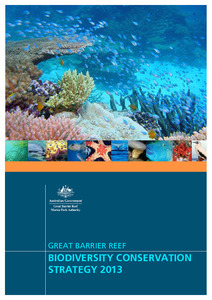Please use this identifier to cite or link to this item:
https://hdl.handle.net/11017/2787Great Barrier Reef Biodiversity Conservation Strategy 2013

View this entry
Full metadata record
| DC Field | Value | Language |
|---|---|---|
| dc.date.accessioned | 2013-05-22T03:42:36Z | null |
| dc.date.available | 2013-05-22T03:42:36Z | null |
| dc.date.copyright | 2013 | en |
| dc.date.issued | 2013 | en |
| dc.identifier.uri | http://hdl.handle.net/11017/2787 | null |
| dc.description.abstract | The Great Barrier Reef Biodiversity Conservation Strategy 2013 provides a framework for improving biodiversity conservation in the Great Barrier Reef Region. It has been developed in consultation with Australian and Queensland government agencies, researchers, industry representatives and conservation groups. The strategy's approach includes continuing to foster industry and community stewardship of the Reef, building ecosystem resilience in a changing climate and improving our knowledge to make more informed decisions. This strategy establishes a process for determining and documenting the habitats, species and groups of species that are potentially at risk. Vulnerability assessments are being completed to identify actions to reduce the threats and pressures facing at-risk biodiversity. Identifying priority habitats and species is vital when managing such a large, complex ecosystem as it allows resources to be directed where help is most needed. The habitats considered to be potentially at-risk are coral reefs, islands, the lagoon floor, mangroves, open waters and seagrass meadows. The species or species groups considered to be potentially at-risk are the dwarf minke whale, dugong, grey mackerel, humpback whale, inshore dolphins, king and blue threadfin salmon, marine turtles, seabirds, sea snakes, sharks and rays (including sawfish) and snapper. | en |
| dc.publisher | Great Barrier Reef Marine Park Authority | en |
| dc.relation.ispartofseries | Policy under s7(4) of the GBRMP Act 1975 | - |
| dc.subject.other | Reef Ecosystems & Marine Species | en |
| dc.title | Great Barrier Reef Biodiversity Conservation Strategy 2013 | en |
| dc.type | Report | * |
| dc.type | Strategy | en |
| dc.format.pages | 42 | en |
| dc.contributor.corpauthor | Great Barrier Reef Marine Park Authority | en |
| dc.publisher.place | Townsville | en |
| dc.subject.collection | Managing Multiple Use | en |
| dc.relation.connectiontogbrmpa | GBRMPA published this item | en |
| dc.subject.category | Animals | en |
| dc.subject.category | Plants | en |
| dc.subject.category | Ecosystems | en |
| dc.subject.category | Processes | en |
| dc.subject.category | Agriculture | en |
| dc.subject.category | Coastal development | en |
| dc.subject.category | Commercial fisheries | en |
| dc.subject.category | Defence | en |
| dc.subject.category | Illegal activity | en |
| dc.subject.category | Ports and shipping | en |
| dc.subject.category | Recreation | en |
| dc.subject.category | Tourism | en |
| dc.subject.category | Traditional use | en |
| dc.subject.category | Leading environmental practice | en |
| dc.subject.category | Climate change | en |
| dc.subject.category | Extreme events | en |
| dc.subject.category | Water quality | en |
| dc.subject.category | Coastal communities | en |
| dc.subject.category | Councils | en |
| dc.subject.category | Farmers and graziers | en |
| dc.subject.category | Fishers | en |
| dc.subject.category | Recreational users | en |
| dc.subject.category | Reef managers | en |
| dc.subject.category | Schools | en |
| dc.subject.category | Tourism operators | en |
| dc.subject.category | Traditional owners | en |
| dc.subject.location | Reef-wide | en |
| dc.keywords | biodiversity, species, habitats, vulnerability, | en |
| Appears in Collections: | Ecosystems | |
Files in This Item:
| File | Description | Size | Format | |
|---|---|---|---|---|
| GBR BCS 29 April 2013_BD2_MAR.pdf | Main document | 4.47 MB | Adobe PDF |  View/Open |
| BioConStrat-26-April-2013.docx | 6.47 MB | Microsoft Word XML | View/Open |
Items in the ELibrary are protected by copyright, with all rights reserved, unless otherwise indicated.
